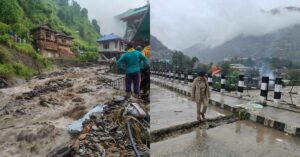Kangra Fort, Once a Trove of Royal Treasures, Withstood 52 Attacks but Crumbled to Nature’s Wrath
The Kangra fort is India's oldest dated fort, said to be built around 3,500 years ago by Maharaja Susharma Chandra, a descendant of the Katoch family.
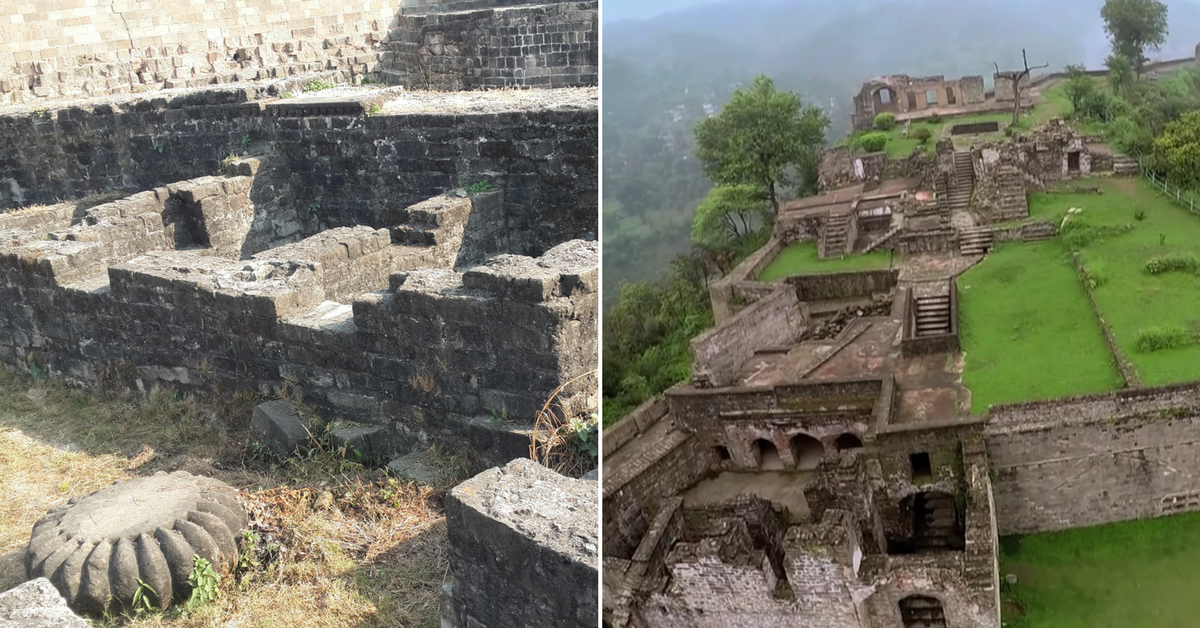
Once a well of treasures, this ancient fort was looted by a number of enemy armies — from Muhammad Bin Tughlaq to the British –but its final fall was to nature.
Kangra Fort is located 20 km from Dharamsala, on the outskirts of the town of Kangra in Himachal Pradesh. It’s the largest fort in the Himalayas and, according to the Archaeological Survey of India, it is 8th largest in the country – covering an area of 463 acres.
The fort is also India’s oldest dated fort, said to be built around 3,500 years ago by Maharaja Susharma Chandra, a descendant of the Katoch family.
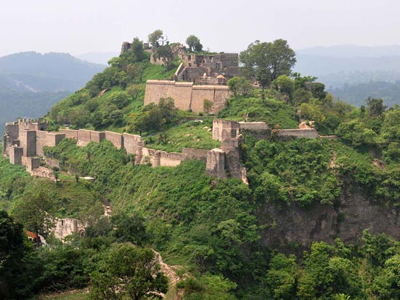
This royal Rajput family is said to be founded by Rajanaka Bhumi Chand in 4300 B.C. Legend has it that there was a time when Goddess Ambika (a form of Goddess Parvati) was fighting a ferocious demon. In the long and hard battle, a drop of the goddess’s sweat fell on Earth. From this emerged Bhumi Chand of the Chandravansh (the moon clan), who helped the goddess fight the demon. As a blessing, Ambika granted him the kingdom of Trigarta, located between the three rivers – Sutlej, Beas and Ravi. Kangra is a part of this region.
It is believed that Maharaja Susharma Chandra of Katoch dynasty had built Kangra Fort. He fought for Kauravas in Mahabharta battle. After the defeat of Kauravas, Susharma Chandra didn’t return to his capital in Multan but came to Kangra along with his soldiers. He took Trigarta under his control and built the fort to protect his kingdom.
“You must pass through the gate leg first, never lead with your head because if there’s an enemy on the other side, you might lose your head,” was the tip given to Tikaraj Aishwarya Katoch, the present scion of the erstwhile Katoch dynasty by his grandfather while entering the entry gate called the Ranjit Singh Gate, when he first visited the fort. He speaks about this in an audio tour guide provided by the Archeological Survey department of India when you visit the fort.
Aishwarya meant here that it was better to lose one’s leg rather than their head while entering the fort, since in all possibility; a lurking guard would simply behead whoever entered. This was because such was the lure of the fabled riches and jewels stored here that Alexander the Great, Mahmud Ghazni, the Mughal ruler Jahangir, Maharaja Ranjit and the British had all attempted to control it.
The kings of Hind, the chief of Kangra and all the rich devotees of the Brijeshwari Temple sent their treasures and precious jewels time after time to be presented to the large idol within the temple, so that they may receive a reward for their good deeds. The accumulation of years had attained such an amount that the backs of camels could not carry it, nor vessels contain it, nor writers hand record it and nor the imagination of an arithmeticians conceive it. It is said that the fort is supposed to have had a greater quantity of gold, silver, precious stones and pearls, than was ever collected in a Royal treasury.
Quite predictably then, this fort has been subjected to countless attacks and almost all rulers who ever walked the land of India tried to take the Kangra Fort under their control as it was said: ‘He who holds the Kangra fort, holds the hills.’
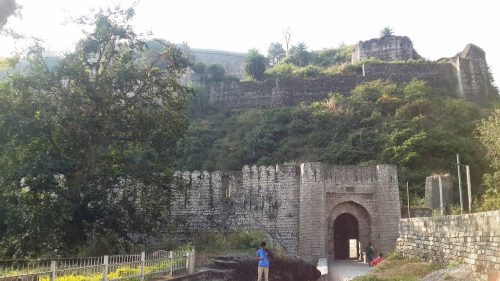
Photo credit -Aditya Katoch
The first attack on this fort was by Raja of Kashmir Shreshta in 470 A.D.
The earliest records of foreign invasions on Kangra fort refer to attacks by Mahmud of Ghazni back in AD 1009. The Persian ruler was said to be captivated by the immense treasures of the Kangra fort.
Muhammad Bin Tughlaq, the Turkic Sultan of Delhi, was the next ruler to capture the fort later in 1337. And after his death in 1351, his successor Feroze Shah Tughlaq conquered Nagarkot in the same year.
It is interesting to note that Mahmud was the first enemy to ever step foot in the fort. His attack was so swift that the garrison commanding the fort and the town could not even close the gates of the city wall (the Katoch armies had been greatly reduced in number because the Raja of Kangra Jagdish Chandra was out on an expedition against the Raja of Kaluta – present day Kullu).
After gaining access into the town the sultan blackmailed the garrison commander within the fort (with the lives of the town citizens). Under these circumstances, the fort was handed over to the sultan who, after taking control of the fort, killed all its occupants. Abu Nasir Ahmed bin Mohammad Farighuni the ruler of Juzjan, Altuntash and Asightigin (Sultan’s chief chamberlains) – were appointed incharge of the gold and silver. The sultan himself took charge of the jewels.
The Kangra fort is said to have 21 treasure wells – each well is 4 meters deep and about 2 and a half meters in circumference-the Sultan of Ghazni looted eight wells, the British in the 1890s found five more wells. Local beliefs are that the fort still hides within its wall eight more treasure wells.
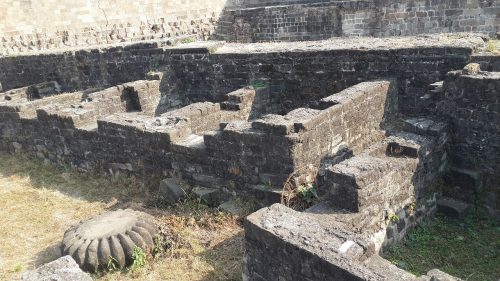
Photo Credit – Aditya Katoch
In 1619, the Mughal army laid siege to the fort for nearly 14 months, for which as many as 52 unsuccessful attempts had been made since 1615 by Akbar. And finally in 1620 Akbar’s son Jahangir could capture this fort.
In 1758, Sansar Chand’s grandfather, Ghamand Chand the predecessor of the Katochs, had been appointed governor of Jalandhar by Ahmed Shah Abdali. Building upon this background, Sansar Chand rallied an army, ousted the then-ruler of Kangra, Saif Ali Khan, and succeeded in recovering the ancient fort of his ancestors in 1789.
Maharaja Sansar Chand had successfully established himself as a powerful ruler till that time and was able to set a deal with Jai Singh (King of Jaisinghpur in Kangra Valley) and gained control over the fort. He had to give some plain territories to Jai Singh in return.
This was when Sansar Chand emerged as a dominating ruler and conquered almost all neighbouring regions, including Chamba, Kahloor, Mandi and Sirmaur.
All the defeated hill kings then sought help from Amar Singh Thapa, the Gurkha commander, and came together against Sansar Chand. They invaded Kangra with Gurkha troops and won the fort.
Maharaja Sansar Chand fought multiple battles with the Gurkhas on one side and another king, the Sikh Maharaja Ranjit Singh, on the other.
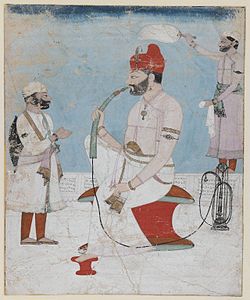
Photo Source – Wikimedia
During battle, the gates of the fort had been kept open for supplies. The Gurkha army entered the open and scarcely armed gates in 1806. This forced an alliance between Sansar Chand and Ranjit Singh. Sansar Chand had to agree to transfer Sandhata district and the Kangra fort to the Lahore Darbar. A treaty was signed and the rulers of Kangra never gained control of the fort again, and the Gurkhas eventually left too. The fort was finally taken by the British after the Sikh war of 1846.
A British garrison occupied the fort until it was heavily damaged in an earthquake on April 4, 1905.
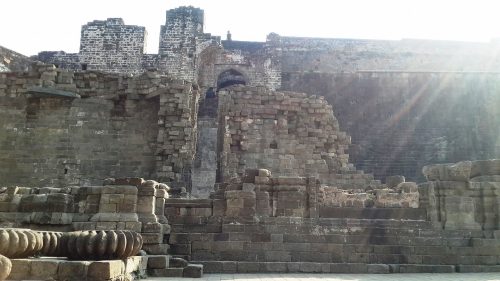
Photo Credit – Aditya Katoch
The magnitude-7.8 earthquake killed more than 20,000 people. Apart from this, most buildings in the towns of Kangra, Mcleodganj and Dharamsala were destroyed. What no army could do in hundreds of years, nature did–it literally shook the foundations of the Kangra fort.
The fort is spread over a large area on both sides via a 4-km-long outer circuit. The entire Fort is guarded by high rampant parts and massive walls of black stones. The highest point is occupied by the palace courtyard, below which there is a large courtyard containing the stone carved temples of Laxmi Narayan, Ambika Devi and the Jain Temple (a point of pilgrimage for the Jains as it holds the original idol of Mahavir). The fort has a total of 11 gates and 23 bastions.
The temple courtyard is closed by the Darshani Darwaza (the gate of worship), the next gate leading up from here is called the Mahlon ka Darwaza (palace gate).
Outside the main temple gate lies the first defence gate called the Andheri Darwaza (dark gate).
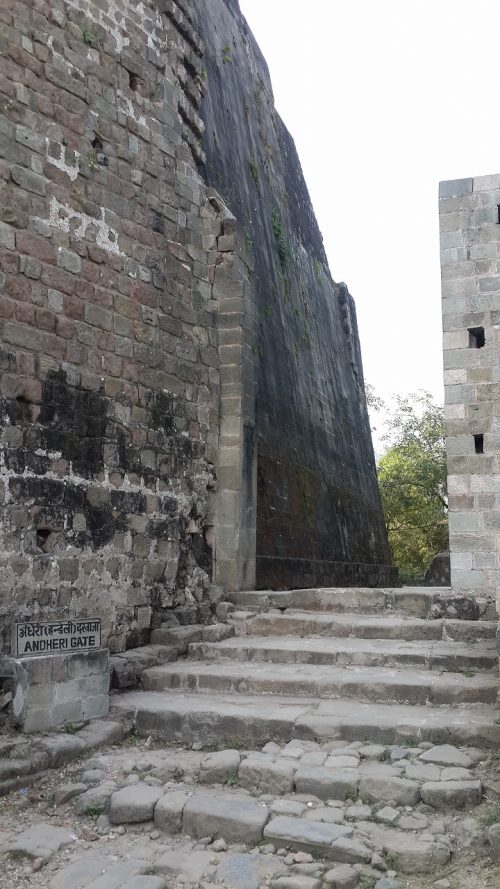
Photo Credit – Aditya Katoch
This gate is a passage 7 m in length and is wide enough only for two men (shoulder to shoulder) or one horse to pass through and its walls are almost 15 feet high. This was built in order to stop/slow down the charge of an enemy army – above the side walls are flat grounds that accommodated the Katoch army, which defended these gates from the vantage point.
After independence, the Archaeological Survey of India returned the fort to Maharaja Jai Chandra under a management agreement of national importance. The only portions of the fort still under the control of the present family are the temples and parts of the palace courtyards.The Katochs still come to offer their prayers to their deity, Goddess Ambika Devi, whose temple still remains intact inside the fort.
Featured image – Youtube (Epic Channel)
Like this story? Or have something to share? Write to us: [email protected], or connect with us on Facebook and Twitter.
NEW: Click here to get positive news on WhatsApp!
This story made me
- 97
- 121
- 89
- 167
Tell Us More
We bring stories straight from the heart of India, to inspire millions and create a wave of impact. Our positive movement is growing bigger everyday, and we would love for you to join it.
Please contribute whatever you can, every little penny helps our team in bringing you more stories that support dreams and spread hope.







